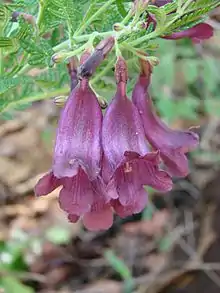Jacaranda ulei
Jacaranda ulei is a flowering tree native to the Cerrado region of Brazil.[1][2] It was first described by Édouard Bureau and Karl Moritz Schumann in 1897.[3]
| Jacaranda ulei | |
|---|---|
 | |
| Jacaranda ulei flower | |
| Scientific classification | |
| Kingdom: | Plantae |
| Clade: | Tracheophytes |
| Clade: | Angiosperms |
| Clade: | Eudicots |
| Clade: | Asterids |
| Order: | Lamiales |
| Family: | Bignoniaceae |
| Genus: | Jacaranda |
| Species: | J. ulei |
| Binomial name | |
| Jacaranda ulei | |
Description
Jacaranda ulei is a small tree, growing to between 0.6 metres (2 ft 0 in) and 1.5 metres (4 ft 11 in) tall. The leaves are 6 to 10 cm in length and bipinnate, having between 8 and 12 pinnae and 6 to 16 leaflets. Leaflets are 15 to 20 cm long, 3 to 5 cm wide and "narrowly oblong" in shape. The flowers are deep purple in colour and arranged in a branched, Panicle form. They are 5 to 10mm long and 4 to 7mm wide with 5 shallow dentate. The fruit is woody and "round to elliptic" in shape, growing 3.5 to 5.5 cm long and 3 to 4 cm wide.[4]
The species is a resprouter, with its root system allowing it to survive wild fires and droughts seen in the savanna ecosystem of the Cerrado region of Brazil.[2]
Uses
The roots of the plant have been used as a traditional folk remedy to treat urinary tract infections, amoebiasis, backache, rheumatism and skin disorders.[2]
References
- "Jacaranda ulei Bureau & K.Schum". Kew Science. 21 June 2018.
- Da Silva, Paulo R. D.; Stefenon, Valdir M. (2014). "Histological features, starch accumulation and sprouting in the early root development of Jacaranda ulei(Bignoniaceae)". An. Acad. Bras. Ciênc. 86 (1): 271–276. doi:10.1590/0001-37652013109212.
- Flora Neotropica, Issue 25, Part 2. Published for Organization for Flora Neotropica by the New York Botanical Garden. 1992. p. 105. ISBN 9780893273682.
- "Monographs Details: Jacaranda ulei Bureau & K.Schum". World Flora Online. Retrieved 21 June 2018.